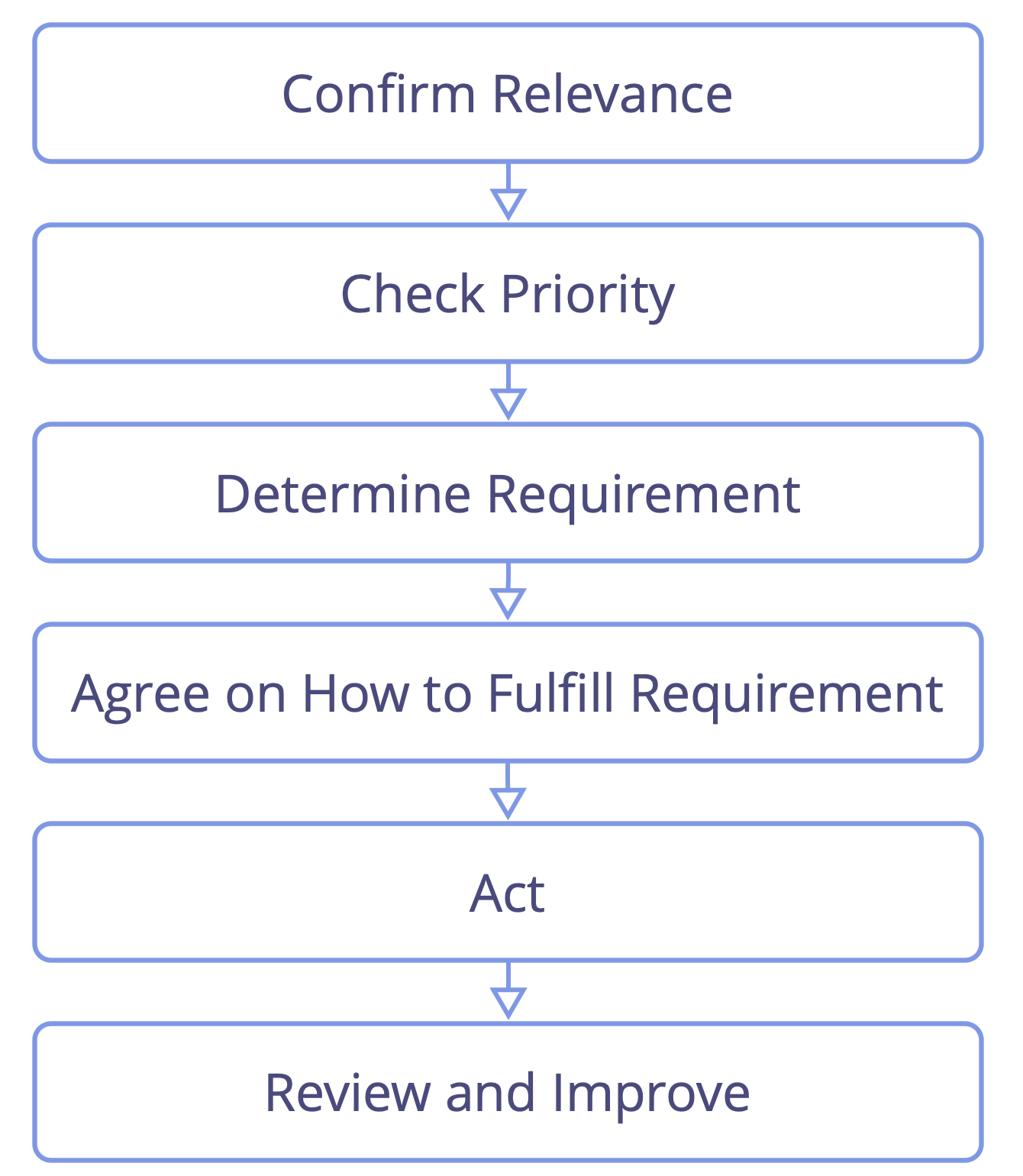Répondre aux Moteurs Organisationnels
Table des matières
- Aperçu
- Step 1: Confirm Relevance
- Step 2: Determine Priority
- Step 3: Determine the requirement
- Step 4: Agree on how to fulfill the requirement
- Step 5: Act
- Step 6: Review and Improve
Aperçu
When a role keeper or a team becomes aware of a new driver they are responsible for dealing with, it’s usually ineffective to drop everything else and do the first thing that comes to mind to respond to it.
Here’s a series of steps you can take which will support you to make the best use of your time and resources:
- Confirm that this situation is both relevant for the organization to respond to, and that responding is the responsibility of you or your team.
- Trier le dans votre backlog en fonction de sa priorité. When it’s time to respond to the driver:
- Determine the requirement
- Decide on how to fulfill the requirement
- act on what’s been agreed
- Regularly review outcomes and, if needed, adapt your decision to improve it, based on what you learn.

Step 1: Confirm Relevance
As a role keeper or team, before responding to a driver, it is essential to verify both that the driver is relevant for the organization to respond to (i.e. it is in fact an organizational driver), and that it’s yours or your team’s responsibility to deal with it, or at least, that your doing so is beneficial and that it will cause no impediment or harm.
If you think that a driver is relevant, but it’s someone else’s responsibility to deal with it, pass it on to them instead (see also Navigate via Tension).
To keep track of new drivers that you become aware of (or that others identify and pass on to you) it’s useful that for each domain you set up a dedicated place to receive them, such as a column in a kanban board called “inbox” or “incoming” where information about potentially relevant drivers can be placed.
Step 2: Determine Priority
Une fois que vous avez décidé qu’un moteur est décrit assez clairement et qu’il est pertinent d’y répondre, il doit être priorisé et déplacé vers le backlog approprié, pour être récupéré et traité en conséquence.
Even if a situation is relevant to the organization and it falls within your area of responsibility to deal with it, this doesn’t imply that it’s also a priority to do something about it immediately. There may be many other organizational drivers that are more important to deal with first. Par conséquent, les nouveaux moteurs doivent être priorisés par rapport aux autres tâches, afin de rester concentré sur ce qui est le plus important, et toujours travailler efficacement à la réalisation de vos objectifs.
Step 3: Determine the requirement
After establishing that a driver is both relevant and a priority, it’s helpful to determine the requirement – what you consider is needed or desirable to effectively respond to the situation – before narrowing down on a specific solution.
Une exigence est un besoin ou un désir jugé nécessaire pour répondre de manière adéquate à un moteur organisationnel, ou jugé comme une prochaine étape utile.
In some cases, the requirement is already clear, because there is an existing agreement that governs how to deal with drivers like this. In this case, simply continue with step 4. Otherwise refer to the pattern Determine Requirement for guidance.
Step 4: Agree on how to fulfill the requirement
Fulfilling a requirement can include:
- l’action directe (opérations)
- organiser comment le travail sera fait
- making or changing agreements (including creating new roles, teams, projects, etc.)
In the absence of any existing agreement that guides people on how to fulfill a requirement, those with responsibility for responding to the driver will need to decide for themselves how to do this. For situations where co-creating a solution as a group is valuable or necessary, consider using one or more of the S3 patterns for decision-making such as Proposal Forming, and Consent Decision Making.
Step 5: Act
Finally, it’s time to act on what was agreed.
Step 6: Review and Improve
It’s helpful to regularly review decisions in light of the outcomes that arise from acting on them, so you can reflect on learning and use that information to identify opportunities for improving any decisions you have made.
As well as reviewing outcomes, remember to also review your decisions regarding:
- Your interpretation of the driver, including to evaluate whether a the driver is still relevant, or if the situation has changed
- l’exigence
- The specific decision you made for how to fulfill the requirement
For more information on reviewing agreements, check Evaluate and Evolve Agreements.